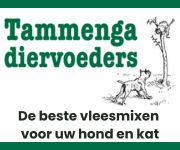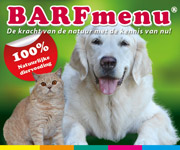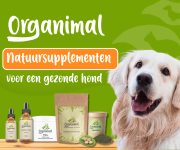Misschien is dit wel een interessant stukje:
http://www.vegetarisme.be/php/EM10_over ... ss=2&sss=1
Het legt ook uit dat verschillende zeewieren en preparaten andere hoeveelheden jodium kunnen bevatten. Het legt ook goed uit wat een teveel aan jodium doet. Bij de mens welliswaar, maar ik heb al diverse artikeltjes gelezen waarbij deze problemen ook voor honden gelden.
Ik heb ook in diverse boeken (waaronder die van Lowel Ackerman) gelezen dat commerciele voeding verrijkt wordt met zout waaraan jodium is toegevoegd. Aangezien onze honden dat niet krijgen, moeten zij hun jodium halen uit: zeevis, zeegroente en zeewieren. En ik denk dat als je hond geen zeevis en geen zeegroente (zoals zeekraal ofzo) eet, dat je gerust wat kelp/zeewier aan je hond kan geven. Maar volgens mij moet je het niet overdrijven... Er staat voor mensen dat 2 kelptabletten per week eigenlijk wel zatjes is. En waarom zou je je hond dan iedere dag zoveel zeewier geven? Zeewier is met stip de rijkste bron van jodium, hoewel Nori een relatief laag jodiumgehalte bevat en je daar dan dagelijks wat van zou mogen nemen. Volgens mij is Ascophllum nodosum rijker aan jodium. En ik denk dat Plaque Off en een willekeurig ander Ascophllum nodosum poeder niet met elkaar vergeleken kunnen worden en ze beide een andere hoeveelheid jodium kunnen bevatten. Nou zou je denken dat Plaque Off wel gekeken heeft naar de hoeveelheid jodium die de hond binnen krijgt middels hun poeder. En ik mag er vanuit gaan dat ze dat naast de hoeveelheid jodium hebben gelegd die een hond al binnen krijgt middels brokkies. Want dat is wat de gemiddelde hond eet, nietwaar? Dus ik zou denken dat hun product, gebruikt door barfers, veilig is in de door hun aangegeven dosering? Tenminste, dat mag ik hopen. Toch?
Nog even wat andere info over kelp/zeewier:
Als ik zin heb, zal ik ook eens aan het rekenen slaan. Ik zal even citeren uit het boek van Lowell Ackerman.
"Kelp (ascophyllum nodosum) reccomendations: may be a good general supplement to provide vitamines, minerals, and trace elements (sporenelementen), but it is not nutritionally complete on its own. It is considered to be save.
Cautions: administer kelp cautiously to dogs that are already receiving more than adequate levels of iodine. In some dogs, kelp may cause diarrhea or constipation, and it commonly changes the stool to a green color".
Waar zit nog meer jodium in: zout met jodium, zeegroente, zeevis.
Aangezien wij barfers geen brokken geven waar zout + jodium aan toe is gevoegd, kunnen we er vanuit gaan dat ze geen jodium binnen krijgen tenzij we zeegroente + zeevis geven. Geven we dat niet, komt er geen jodium binnen. En geen is ook een beetje weinig. In dat opzich kan kelp volgens mij geen kwaad, tenzij je veel zeegroente of veel zeevis geeft.
En dan nog ff dit stukje:
Around 1900, scientists first recognized that iodine was required for the proper functioning of the thyroid gland and that an iodine deficiency caused goiter. Shortly thereafter, iodized salt became widely accepted as a means of preventing goiter in man and animals.
In humans goiter and cretinism are no longer considered the main consequence of iodine deficiency, although these are the easiest signs of an iodine deficiency to detect. Recent research has shown that for every cretin living in an iodine deficient community, two pregnancies have ended in miscarriage, stillbirth or neonatal death (245). The survivors in an iodine-deficient population suffer from a higher incidence of developmental and functional abnormalities, including speech, hearing and neuro-muscular function. These symptoms are also expressed in a 10-15 point decrease in average I.Q. The term “Iodine Deficiency Disorders or IDD” has been coined to describe this condition.
The thyroid gland contains the highest concentration (0.2% to 5% on a dry weight basis) of iodine in the body; between 70% and 80% of the total body stores. Approximately 90% of the iodine which passes through the thyroid gland is captured by that organ (244). Iodine is then combined with tyrosine in the thyroid to form diiodotyrosine. Two molecules of this compound are then combined to form thyroxine. Approximately 80% of the thyroxine entering the circulation is broken down through de-iodinization by the liver, kidney and other tissues.
De-iodinization by these organs may appear counter productive at first glance, but recent research has elucidated its beneficial effect and the role selenium plays in the process. The first clue that selenium deficiency influenced iodine metabolism from selenium depleted rats where there was an increase in the thyroxine to triiodothyronine in the blood. Research by Arthur (246) and Donald (247) confirmed that the same changes occurred in cattle and sheep, respectively. A seleno-protein has been identified that is capable of transforming thyroxin to the more biologically active triiodothyronine. This deiodinase is located primarily in the liver and kidney with none in they thyroid gland itself (219). A second selenium containing deiodinase is located in the brain and brown adipose tissue. This is especially important in the newborn where thermogenesis is directly related to the activity of the brown adipose tissue. Consequently, iodine metabolism is greatly influenced by selenium nutrition, and thus indirectly influences basal metabolic rate and a host of physiological processes. Free iodine is conserved and recycled by the body with only 20% being excreted in the urine and feces (215).
When inorganic iodine is consumed, it is absorbed from the gastro-intestinal tract by two processes. One is common to other halides such as chlorine or bromine, and the other is specific for iodine. The stomach and duodenum not only absorb iodine, but also secrete it in gastric juice. In fact, gastric juice often has an iodine concentration 40 times higher than blood plasma. Iodine absorbed from the blood by the thyroid gland is stored as thyroglobulin. Free iodine is conserved and recycled by the body with only 20% being excreted in the urine and feces (215).
Several dietary factors are goitrogenic. In fact, the dietary concentration of goitrogens is probably a more important determinant of iodine status than dietary iodine levels, in many cases. Cruciferous plants contain potential goitrogens of the thiouracil type, while brassicas and white clover contain cyanogenetic glycosides that are goitrogenic (219). Canola meal has resulted from the selection of rape-seed that is low in glucosinolate, a common goitrogen. There are also specific goitrogenic substances in other feeds (carrots, linseed, cassava, sweet potatoes, lima beans, millets, peanuts, cottonseed, soybeans and others) which slow down the hormone secreting activity of the thyroid gland. Goiter can occur, therefore, even though the iodine level might otherwise be adequate. Other substances can also reduce iodine absorption. For example, a high calcium level in drinking water may slow iodine absorption resulting in goiter, particularly if the iodine level is borderline in meeting body needs.
Crops grown inland, away from the ocean, are usually low in iodine, whereas crops grown near the ocean may be adequate in iodine. For example, it is estimated that 20-50 mg of iodine per acre fall annually in rain along the Atlantic coastal plain, but on 0.7 mg iodine per acre falls in rain in the Great Lakes region of the U.S. The Midwest and Great Lakes region have been the areas where iodine deficiency is most common. Supplemental iodine provided by iodized salt is recommended for use in all areas of the country, because of the uncertainty of where feeds originate.
Some iodine compounds are easily broken down by heat and moisture. Therefore, a stable source of iodine must be used to prevent losses from exposure to sunlight, moisture, or other conditions. Table 25 shows the level of iodine recommended by the latest National Academy of Sciences-National Research Council publications on the nutrient requirements of the species involved. The toxic levels in Table 25 are those indicated in the same NRC publications. Feeding excess iodine should be avoided because it may interfere with thyroid gland function.
Table 25. Iodine Requirement and Toxic Levels1
Class of Animal
Iodine Requirement in Total Diet (ppm)
Toxic Level in Total Diet (ppm)
(in het volgende rijtje is het eerste cijfer het requirement en het tweede cijfer de hoeveelheid die toxic is)
Swine
0.14
800
Beef Cattle
0.5 (0.2-2.0)
502
Dairy Cattle
0.25-0.50
50
Horses
0.1
4.8
Sheep
0.1-0.8
502
Goats
0.15-0.83
83
Poultry
0.3-0.4
625
1 Levels recommended by the latest NRC publication on nutrient requirements, unless indicated otherwise.
2 Maximum tolerable level in diet.
3 Same level as recommended for sheep.
Swine
Symptoms of iodine deficiency in piglets born to iodine deficient sows are thickened skin, puffy necks, hairlessness, and bloated appearance. Some of the piglets are born dead, others are alive but weak and usually die within a few hours. At necropsy, the thyroid is enlarged and hemorrhagic. Iodine deficiency can cause an approximate six-fold enlargement of the thyroid gland (87, 92).
Beef Cattle
Goiter in newborn calves is a sign of borderline or definite dietary iodine deficiency, even though the cows may appear normal. Thyroid glands four to five times normal size sometimes occur in calves, but the abnormality cannot be detected definitely until the calf is slaughtered. Iodine deficient calves may also be born blind, hairless, weak or dead, depending on how severe the deficiency is. Long-term deficiencies may result in decreased milk yields, and decreased fertility in females and males. Iodine deficiency may occur in cattle even at iodine intake levels recommended in Table 12. If as much as one fourth of the feed used is from strongly goitrogenic crops, iodine requirements increase to 0.5 ppm for growing and non-lactating cattle and 1.0 ppm for late gestation and lactating cows (85, 157). In a recent Irish study, iodine deficiency was the most the most prevalent deficiency observed. Plasma iodine concentrations were low in 69% of the 2,612 cattle tested (295).
Dairy Cattle
Lactating dairy cattle require more iodine than beef cattle because approximately 10% of the iodine intake is normally excreted in milk, and this percentage may increase as milk production increases (156). To ensure that the iodine requirements of the high-producing cow are met, 0.6 ppm iodine is recommended.
Horses
Pregnant mares may not show external signs of iodine deficiency but may produce a stillborn foal or one showing extreme weakness at birth, resulting in an inability to stand and suckle the mare. Foals born alive with a well developed goiter will usually die or will remain weaklings if they live. Deficient mares may exhibit abnormal estrus cycles in the absence of goiter. Limited data indicate that "navel ill" in foals may be lessened by feeding iodine to brood mares, but more verification is needed. A decline in libido (sex drive) and semen quality has been noted in Europe with stallions, but this also needs more verification (98, 154).
There is a wide margin between iodine requirement and the maximum tolerable level for all farm animal species except the horse (248). The maximum tolerable level for equines has been estimated as low as 5 ppm. With normal feedstuffs iodine toxicity is extremely rare.
The only feed ingredient that could pose a toxicity risk is seaweed. Seaweed can contain 4,000-6,000 ppm of iodine.
Sheep
In newborn lambs, the more common symptom of iodine deficiency is goiter. If the condition is not advanced, the lambs may survive. Other symptoms are lambs born weak, dead, or without wool. Mature sheep seldom show a change in their appearance. But an iodine deficiency may result in reduced yield of wool and reduced conception rate (155).
Goats
Kids with goiter, as well as weak and dead kids, have been reported at birth. Very little experimental information is available with the goat. Therefore, extrapolated data from sheep studies must be used until additional experimental data become available from studies with goats (100).
Poultry
Goiter occurs in the thyroid gland, causing the thyroid gland to grow to many times its normal size. Histological examination of the thyroid shows hyperplasia and an absence of colloid. Iodine deficiency in breeding hens results in reduced egg iodine levels, reduced egg production, decreased hatchability, prolonged hatching time, and thyroid enlargement in the embryos (95, 141).
Other Animals
"Other animals" include dogs, cats, mink, foxes, rabbits, fish and laboratory animals. In all of these animals and fish, an iodine deficiency results in an enlarged thyroid. With many animals, a level of 0.1 to 0.3 ppm iodine in the diet will meet the iodine requirement. With others, a level as high as 1 ppm is required. Iodine in excessive levels should be avoided, because it may have harmful effects (89, 102, 103, 142, 143, 144, 145).






